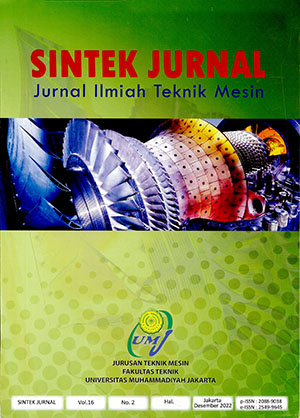Optimization analysis of production capacity on trimming process for passenger vehicle with a learning curve approach (case study: car os)
Main Article Content
Abstract
Article Details
- Articles published in SINTEK JURNAL are licensed under a Creative Commons Attribution-ShareAlike 4.0 International license. You are free to copy, transform, or redistribute articles for any lawful purpose in any medium, provided you give appropriate credit to the original author(s) and SINTEK JURNAL, link to the license, indicate if changes were made, and redistribute any derivative work under the same license.
- Copyright on articles is retained by the respective author(s), without restrictions. A non-exclusive license is granted to SINTEK JURNAL to publish the article and identify itself as its original publisher, along with the commercial right to include the article in a hardcopy issue for sale to libraries and individuals.
- By publishing in SINTEK JURNAL, authors grant any third party the right to use their article to the extent provided by the Creative Commons Attribution-ShareAlike 4.0 International license.
References
C. Canel, D. Rosen, and E. A. Anderson, "Just‐in‐time is not just for manufacturing: a service perspective," Industrial Management & Data Systems, 2000.
D. Sperling and E. Claussen, "Motorizing the developing world," Access Magazine, vol. 1, no. 24, pp. 10-15, 2004.
T. L. Smunt and C. A. Watts, "Improving operations planning with learning curves: overcoming the pitfalls of ‘messy’shop floor data," Journal of Operations Management, vol. 21, no. 1, pp. 93-107, 2003.
D. Hayashi, J. Huenteler, and J. I. Lewis, "Gone with the wind: A learning curve analysis of China's wind power industry," Energy Policy, vol. 120, pp. 38-51, 2018.
P. Micheli, M. Johnson, and J. Godsell, "Editorial How the Covid-19 pandemic has affected, and will affect, operations and supply chain management research and practice," International Journal of Operations & Production Management, 2021.
P.-C. Pedersen and D. Slepniov, "Management of the learning curve: a case of overseas production capacity expansion," International Journal of Operations & Production Management, 2016.
M. J. Anzanello and F. S. Fogliatto, "Learning curve models and applications: Literature review and research directions," International Journal of Industrial Ergonomics, vol. 41, no. 5, pp. 573-583, 2011.
J. B. Mazzola and K. F. McCardle, "The stochastic learning curve: Optimal production in the presence of learning-curve uncertainty," Operations research, vol. 45, no. 3, pp. 440-450, 1997.
H. A. B. Musaddad, "Determinants Of Individual’s Intention To Use Islamic Home Financing Among Industrial Manufacturing Workers."
M. Artigue, "Learning mathematics in a CAS environment: The genesis of a reflection about instrumentation and the dialectics between technical and conceptual work," International journal of computers for mathematical learning, vol. 7, no. 3, pp. 245-274, 2002.
L. Sukarma, F. Hendra, R. Effendi, and E. Mohamad, "The manufacturing technology optimisation model: the crucial contribution of industrial mass-training in improving company performance," in IOP Conference Series: Materials Science and Engineering, 2020, vol. 909, no. 1: IOP Publishing, p. 012049.


